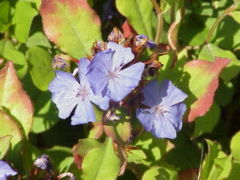Ceratostigma: Difference between revisions
No edit summary |
No edit summary |
||
| Line 4: | Line 4: | ||
Ceratostigma differs from Plumbago in having no glands on the calyx, stamens adnate to the corolla tube, fls. in dense clusters rather than spicate, and other technical characters: lvs. alternate, lanceolate or obovate, more or less ciliate: fls. mostly in terminal heads, blue or rose; calyx tubular, deeply 5-parted, the lobes narrow; corolla salver-shaped, the tube long and slender, the limb spreading and with 5 obovate obtuse or retuse lobes; stamens 5, attached on the corolla tube: fr. a 5-valved caps, inclosed in the calyx. — Species 4 or 5, in N. China, Himalayas, Abyssinia. | Ceratostigma differs from Plumbago in having no glands on the calyx, stamens adnate to the corolla tube, fls. in dense clusters rather than spicate, and other technical characters: lvs. alternate, lanceolate or obovate, more or less ciliate: fls. mostly in terminal heads, blue or rose; calyx tubular, deeply 5-parted, the lobes narrow; corolla salver-shaped, the tube long and slender, the limb spreading and with 5 obovate obtuse or retuse lobes; stamens 5, attached on the corolla tube: fr. a 5-valved caps, inclosed in the calyx. — Species 4 or 5, in N. China, Himalayas, Abyssinia. | ||
Under the name C. Polhilli, a dwarf and creeping shrub, with delicate lavender fls.; is mentioned in British journals as coming from high elevations in W. China and giving promise as an outdoor subject.L. H. B. | |||
}} | }} | ||
{{Taxobox | {{Taxobox | ||
Revision as of 10:07, 28 June 2009
| Standard Cyclopedia of Horticulture |
|---|
|
Ceratostigma (Greek, horned stigma). Plumbaginaceae. Diffuse glabrous perennial herbs or sub-shrubs, one of which is in cultivation as a bedding and border plant. Ceratostigma differs from Plumbago in having no glands on the calyx, stamens adnate to the corolla tube, fls. in dense clusters rather than spicate, and other technical characters: lvs. alternate, lanceolate or obovate, more or less ciliate: fls. mostly in terminal heads, blue or rose; calyx tubular, deeply 5-parted, the lobes narrow; corolla salver-shaped, the tube long and slender, the limb spreading and with 5 obovate obtuse or retuse lobes; stamens 5, attached on the corolla tube: fr. a 5-valved caps, inclosed in the calyx. — Species 4 or 5, in N. China, Himalayas, Abyssinia. Under the name C. Polhilli, a dwarf and creeping shrub, with delicate lavender fls.; is mentioned in British journals as coming from high elevations in W. China and giving promise as an outdoor subject.L. H. B.
|
| Ceratostigma {{{status}}} Fossil range: {{{fossil_range}}}
| ||||||||||||||||||||||||||||||||||||||||||||||||||||||||||||||||||
|---|---|---|---|---|---|---|---|---|---|---|---|---|---|---|---|---|---|---|---|---|---|---|---|---|---|---|---|---|---|---|---|---|---|---|---|---|---|---|---|---|---|---|---|---|---|---|---|---|---|---|---|---|---|---|---|---|---|---|---|---|---|---|---|---|---|---|
 | ||||||||||||||||||||||||||||||||||||||||||||||||||||||||||||||||||
| Plant Info | ||||||||||||||||||||||||||||||||||||||||||||||||||||||||||||||||||
| ||||||||||||||||||||||||||||||||||||||||||||||||||||||||||||||||||
| Scientific classification | ||||||||||||||||||||||||||||||||||||||||||||||||||||||||||||||||||
| ||||||||||||||||||||||||||||||||||||||||||||||||||||||||||||||||||
| [[{{{diversity_link}}}|Diversity]] | ||||||||||||||||||||||||||||||||||||||||||||||||||||||||||||||||||
| {{{diversity}}} | ||||||||||||||||||||||||||||||||||||||||||||||||||||||||||||||||||
| Binomial name | ||||||||||||||||||||||||||||||||||||||||||||||||||||||||||||||||||
| {{{binomial}}} | ||||||||||||||||||||||||||||||||||||||||||||||||||||||||||||||||||
| Trinomial name | ||||||||||||||||||||||||||||||||||||||||||||||||||||||||||||||||||
| {{{trinomial}}} | ||||||||||||||||||||||||||||||||||||||||||||||||||||||||||||||||||
| Type Species | ||||||||||||||||||||||||||||||||||||||||||||||||||||||||||||||||||
| {{{type_species}}} | ||||||||||||||||||||||||||||||||||||||||||||||||||||||||||||||||||
| Species | ||||||||||||||||||||||||||||||||||||||||||||||||||||||||||||||||||
| See text | ||||||||||||||||||||||||||||||||||||||||||||||||||||||||||||||||||
| [[Image:{{{range_map}}}|{{{range_map_width}}}|]] | ||||||||||||||||||||||||||||||||||||||||||||||||||||||||||||||||||
| Synonyms | ||||||||||||||||||||||||||||||||||||||||||||||||||||||||||||||||||
| {{{synonyms}}} |
Ceratostigma (Leadwort) (from the Greek word "Κερατόστιγμα") is a genus of eight species of flowering plants in the family Plumbaginaceae, native to warm temperate to tropical regions of Africa and Asia.
They are herbaceous plants, subshrubs, or small shrubs growing to 0.3-1 m tall. The leaves are spirally arranged, simple, 1-9 cm long, usually with a hairy margin. Some of the species are evergreen, others deciduous. The flowers are produced in a compact inflorescence, each flower with a five-lobed corolla; flower colour varies from pale to dark blue to red-purple. The fruit is a small bristly capsule containing a single seed.
- Selected species
- Ceratostigma abyssinicum (Hochst.) Schwein. & Asch.
- Ceratostigma griffithii C.B.Clarke
- Ceratostigma minus Stapf ex Prain
- Ceratostigma plumbaginoides Bunge
- Ceratostigma ulicinum Prain
- Ceratostigma willmottianum Stapf
Cultivation and uses
C. plumbaginoides is grown as an ornamental plant in gardens for its pale blue flowers and bright red autumn leaves.
References
- Flora of China: Ceratostigma
- Huxley, A., ed. (1992). New RHS Dictionary of Gardening. Macmillan.